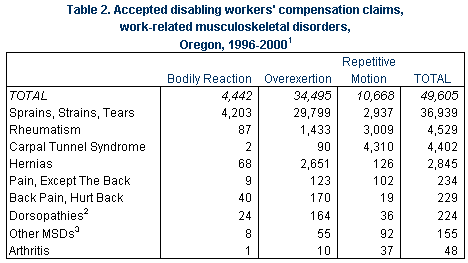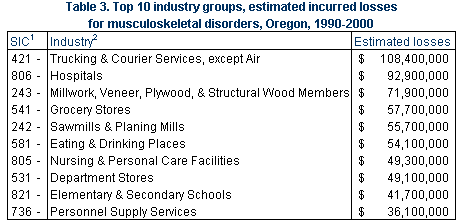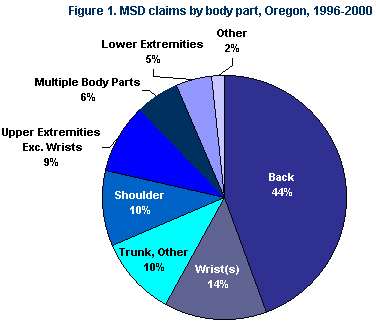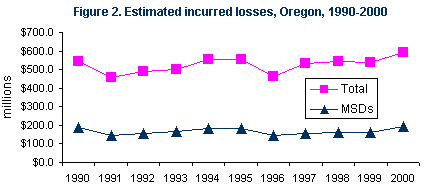
Work-related Musculoskeletal
Disorders,
Oregon, 1990-2000
by Mike Maier and Juli Ross-Mota
Musculoskeletal disorders are sometimes called ergonomic injuries and illnesses. Ergonomics is the study of the worker's interaction with tools, equipment, environment, jobs, tasks, work methods, work rates, and other systems. The federal Bureau of Labor Statistics (BLS) has defined musculoskeletal disorders (MSDs) as injuries and disorders to muscles, nerves, tendons, ligaments, joints, cartilage, and spinal discs. MSDs do not include injuries resulting from slips, trips, falls, or similar accidents. Examples of MSDs include many kinds of sprain and strain, carpal tunnel syndrome, tendinitis, sciatica, and low back pain. MSDs result from bodily reactions due to bending, climbing, crawling, reaching, or twisting, and from overexertion and repetitive motion. All statistics cited in this report are based on the BLS definition of MSDs.
Characteristics of
accepted disabling claims (ADCs)
The rate of accepted disabling claims for MSDs per 100 workers has fallen
by 40 percent since 1990. Simply put, there are fewer reports of ADCs
for musculoskeletal disorders, even though there are more employed Oregonians.
Increased attention to workplace safety and health has played a role in
this decline. Tighter standards for compensability, particularly regarding
pre-existing conditions, have also had an effect. However, the MSDs share
of ADCs has remained fairly consistent over the last 11 years, at slightly
more than 37 percent (see Table 1).

Notes:
1Employment figures are estimated workers' compensation covered
employment developed primarily from data supplied
by the Oregon Employment Department. Figures represent annual average
employment.
2Claims rates are the number of claims per 100 workers. Disabling
claims include fatalities.
|
Of MSD claims accepted in 1996 to 2000, the
back (22,053 claims) and wrists (6,788) were the parts of body stricken
most often.
|
The majority of MSDs have been sprains, strains, and tears caused by overexertion. These claims alone account for 60 percent of all the MSD claims accepted between 1996 and 2000 (see Table 2). Recently however, the share of MSDs due to overexertion has been shrinking as the proportion of disorders resulting from repetitive motion and bodily reaction is on the rise.

Notes:
1In 1995, the Department began using the BLS Occupational Injury
and Illness Classification System (OIICS) for its
claims characteristics data. Characteristics data for years prior to 1996
that has been converted to OIICS is not always
comparable to data in later years, and has been excluded from this report.
2Dorsopathies are conditions of the back or spine, e.g. Sciatica,
Lumbago.
3Includes Osteopathies, Chondropathies, acquired deformities
and unspecified or not elsewhere classified natures.
Non-farm laborers had the highest number of claims, 24,437 (20% of all MSD claims), from 1990 to 2000. Other occupations with a large share of claims for this time period include service occupations at 21,695 (18%) and operatives, except transport, 16,052 (13%). The average age for MSD claimants was 37 years old, the same age at injury as for all workers with accepted disabling claims. From 1996 to 2000, the share of ADCs filed by women for musculoskeletal disorders was 16% greater than the share filed by women for all ADCs.
Costs
Loss costs (incurred losses) are the costs of all benefits paid out of
workers' compensation premiums to an injured worker, over the life of
a claim. Figure 2 shows an estimate of total incurred losses in comparison
to a derived estimate of incurred losses for musculoskeletal disorders1.
Losses for MSDs are substantial, at around $190 million in 2000, and more
than $1.8 billion over the 11-year period.
Table 3 displays the top 10 industry groups by estimated losses for MSDs.
"Trucking and Courier Services, except Air" is the industry
group with the largest losses, at almost $110 million over the 11-year
period ending in 2000.

1Standard Industrial Classification Manual, 1987.
2Industries covered by Workers' Compensation laws.
Loss costs represent the most direct costs of workplace injuries and illnesses,
but the total economic burden of work-related injuries and illnesses is
more than the cost of worker's compensation benefits paid from insurance
premiums. Other costs to consider are, payment of benefits from special
funds (such as for Oregon's Reemployment Assistance Program), productivity
losses in the workplace, and administrative expenses for paying benefits
and investigating accidents. A broad rule of thumb is that the true costs
of all workplace injuries is at least triple the cost of worker's compensation
benefits.2
1Estimates of losses as of July 2001. These estimates may change as matured information becomes available from insurers. Losses for MSDs are derived from the ratio of insurer-reported costs at closure for MSD claims and total insurer-reported costs at closure. Loss costs include denied and medical-only claims, as well as ADCs.
2See, for example, the National Safety Council's Injury Facts and Liberty Mutual's Liberty Mutual Workplace Safety Index.
DCBS Public Home Page | DCBS Site Search | IMD Search |IMD Home Page
If you have questions about the information contained in this document, please contact by e-mail or phone: Mike Maier or Juli Ross-Mota, Research Analysts, Research & Analysis Section, Information Management Division (503) 947-7352 or (503) 947-7359.This web page was last revised: 10/12/01

